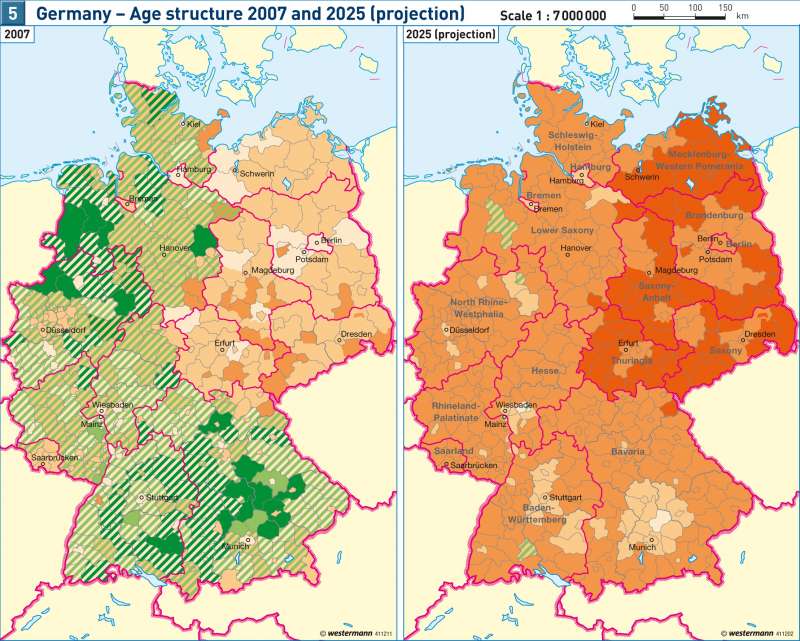Germany — Age structure 2007 and 2025 (projection)
Europe - Population
978-3-14-100790-9 | Page 43 | Ill. 5

Information
One of the central components of demographic change is ageing. This ageing process can be well appreciated from the example of the Federal Republic of Germany, the country with the largest population in the European Union. The trigger for this process is a sharp fall in the birth rate, which occurred in Germany in two phases — between 1880 and the First World War and from the mid-1960s to the mid-1970s. Since then the proportion of younger people has fallen from generation to generation, while on the other hand the proportion of older people has risen. The latter trend is significantly reinforced by the general increase in life expectancy.The maps show the current and projected age structure of the German population in the years 2007 and 2025, based on urban and rural districts and in comparison to the averages for the EU and for Germany as a whole. In terms of the labour market, the population can be subdivided into three main groups: the "not yet actives" (in this case the under-20s), the "actives", and the "no longer actives" (in this case the over-60s). The ageing process can take place at two ends: either the proportion of young people is particularly low or the proportion of old people is particularly high. When there are very few young people and very many old people at the same time, the ageing process is particularly advanced. In Germany this is especially easy to recognise by comparing the two maps. Districts with a higher proportion of younger people in comparison to the overall German average in 2007 are restricted to the territory of the former West Germany. By contrast, districts with an above-average proportion of older people in comparison to the EU average are to be found in 2007 across-the-board in the former East Germany, and in 2025 in the whole of Germany, whereby the majority of districts in the territory of the former GDR have particularly high proportions of older people (over 40%).
Causes of the East-West Gap
In terms of the age structure in Germany, a wide gap between east and west is anticipated by 2025, with an emphatic "over-ageing" in the east. This phenomenon is new, because at the time of German reunification and beyond the East German population was younger. Now however, all the determinants of population development underline the accelerated ageing process in the former East Germany.
Firstly, the sharp fall in fertility will lead to thinly-populated age cohorts among the younger generation. Rising life expectancy, mainly reflected in a reduction in age-specific mortality, will result in more old people who will live to an even higher average age. A further significant factor is age-selective internal migration: the mobile population group is substantially younger than the settled population group. Thus, regions with a migration gain mainly import younger people, while those with a migration loss age more quickly. This age-selectivity also applies to international migration. Overall the ageing process in Germany is slowed by migration gains from abroad. But since the former East Germany participates in this process to a proportionately much lower degree, it profits from it much less than the former West Germany. As a consequence of the low level of migration gain, it too will age somewhat more slowly, but compared with some regions in the west its ageing process will be much faster than those regions with higher inward migration.
Delayed Consequences of Internal Migration
In the former West Germany there are also a few regions in which an increasingly ageing population is to be expected. This phenomenon is mainly the result of long-term migration patterns. Regions with structural economic problems and a long tradition of outward migration, especially among younger people, experience the same fall in birth rates in the second generation that was caused in East Germany by reunification. These delayed consequences of migration movements will be felt especially strongly in the old industrial conglomerations of the Ruhr Area and Saarland, in structurally weak rural regions in Rhineland-Palatinate, northern Hesse and southern Lower Saxony, and in a wide strip of Franconia on the border with the Czech Republic.
H. Bucher/B. Richter; Ü: J. Attfield




